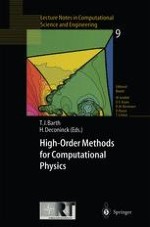The development of high-order accurate numerical discretization techniques for irregular domains and meshes is often cited as one of the remaining chal lenges facing the field of computational fluid dynamics. In structural me chanics, the advantages of high-order finite element approximation are widely recognized. This is especially true when high-order element approximation is combined with element refinement (h-p refinement). In computational fluid dynamics, high-order discretization methods are infrequently used in the com putation of compressible fluid flow. The hyperbolic nature of the governing equations and the presence of solution discontinuities makes high-order ac curacy difficult to achieve. Consequently, second-order accurate methods are still predominately used in industrial applications even though evidence sug gests that high-order methods may offer a way to significantly improve the resolution and accuracy for these calculations. To address this important topic, a special course was jointly organized by the Applied Vehicle Technology Panel of NATO's Research and Technology Organization (RTO), the von Karman Institute for Fluid Dynamics, and the Numerical Aerospace Simulation Division at the NASA Ames Research Cen ter. The NATO RTO sponsored course entitled "Higher Order Discretization Methods in Computational Fluid Dynamics" was held September 14-18,1998 at the von Karman Institute for Fluid Dynamics in Belgium and September 21-25,1998 at the NASA Ames Research Center in the United States.
